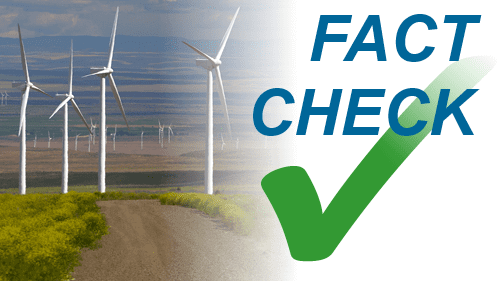Fact Check: New evidence rebuts Heartland's bogus RPS claims
State Renewable Portfolio Standards (RPSs) are widely known to be effective policy solutions, encouraging the growth of affordable, homegrown wind power that the American public supports.
However, that hasn't stopped the Heartland Institute from publishing unreliable, misinformed blogs in recent weeks about the effect of RPS laws and electric rates in Kansas, Ohio, Colorado, and North Carolina. Fortunately, we can provide you with the facts.
States with wind energy fare better, much better
As we explained in a report released this week, new Department of Energy data show that consumers in states with the most wind energy have fared far better than consumers in states that use less wind energy. The chart below illustrates how the eleven states that produce more than seven percent of their electricity from wind energy have seen their electricity prices fall 0.37 percent over the last five years, while all other states have seen their electricity prices rise by 7.79 percent. More than a dozen studies and numerous utilities confirm that wind energy is benefiting their customers.
Electricity Price Changes, 2008 – 2013
In our analysis of the DOE data we looked across all 50 states, a far more comprehensive sample than Heartland’s attempt to cherry-pick four states to support its argument. More importantly, we looked specifically at the use of wind energy in each state, rather than the mere existence of an RPS that may or may not have actually deployed wind energy.
Below, we go state by state to look at what likely caused the electricity price increases Kansas, Ohio, Colorado, and North Carolina, and how wind energy is actually serving to keep electric rates low for consumers in those states. As you’ll see, Heartland couldn’t have cherry-picked a group of states that more clearly contradicted their argument, as wind energy could not have significantly increased electric rates in any of these four states.
KANSAS
Kansas has a robust RPS program, requiring 20 percent of its peak demand capacity to come from renewable resources by 2020. Thanks to its excellent wind energy resources, the prices of Kansas wind power contracts are extremely competitive. Utilities in both Kansas and Colorado have signed wind power purchase agreements at some of the lowest prices seen anywhere in the U.S., locking in consumer savings and protecting their ratepayers from fuel price increases for decades.
The cost of providing other forms of electricity to consumers has been increasing, and in Kansas, upgrades to aging plants have prompted Kansas City Power & Light to request rate increases. Westar Energy also sought rate increases for its customers to help finance its share of necessary upgrades to outdated facilities. The Kansas Corporation Commission has itself estimated that the RPS has affected rates less than 2 percent: a far cry from the 19.4 percent increase that Heartland blames on clean energy.
Kansas has embraced wind energy as a vital part of its manufacturing and jobs base, and as a result, Kansas wind power has grown into an impressive industry creating thousands of jobs and a capital investment of over $7 billion in Kansas.
COLORADO
Colorado’s renewable energy standard is one of the country’s most robust, requiring investor-owned utilities to obtain 30 percent of their power from renewable resources by 2020. Colorado utilities readily promote wind power as a way to reduce costs.
Like in Kansas, the largest impact on consumer rates in Colorado has come from retrofits and retirements at old conventional power plants.
Wind power is saving consumers money now and for decades down the road. With power purchase agreements for wind energy guaranteeing electricity at a fixed cost for 20 years, wind acts as a valuable hedge against increasing fuel prices and other long-term risks.
The Colorado RPS has never exceeded its rate cap of 2 percent, and lately it has hovered at less than one percent. Wind energy, the backbone of the state’s RPS, is helping Coloradoans save on their electric bills. For example, the contract for Colorado’s Limon II farm is priced at a remarkably low 2.9 cents per kilowatt-hour.
As Xcel Energy President and CEO Ben Fowke pointed out, “[Wind power] works out to a very good levelized cost for our customers…These prices are so compelling, the energy [cost] associated with it is less than you can do locking in a 20-year gas strip.”
OHIO
The Ohio RPS requires that 25 percent of the state’s electricity be produced by alternative sources by 2025, with 12.5 percent of that total coming from qualified renewable resources, such as wind power, by 2024.
Ohio electricity prices have gone up primarily because of increases in the price of older conventional energy resources. 78 percent of Ohio’s power comes from these sources, so they have by far the largest impact on electricity price changes in the state.
In Ohio, 80 percent of voters favor laws requiring the state to produce a portion of its electricity from clean energy, citing wind and solar power as particularly important.
In addition to the clear evidence that wind energy actually drives consumer electric bills down, there is another major problem with Heartland’s claims. Many state Renewable Portfolio Standards (RPSs), including those in Ohio and Colorado, have provisions written into the state law that the standard will not apply if it causes consumer electric rates to increase by more than a couple percent. That has never happened for any state RPS, clearly contradicting Heartland’s claim that these state RPSs have caused double-digit increases in electricity prices.
NORTH CAROLINA
It is difficult to argue that wind energy has had any impact – good or bad – on consumers in North Carolina, because North Carolina has a total of zero commercial wind projects in the state. Similarly, Ohio currently only has a handful of wind projects in operation. While both states are likely to see significant renewable energy development in coming years, that future wind energy growth has nothing to do with ratepayer electricity rates currently.
Like Ohio, North Carolina depends heavily on older conventional energy sources that have experienced price increases. With these resources comprising about half of the state’s electricity mix, they have tremendous influence over the price consumers see in their monthly bills.
Conclusion
Despite Heartland's misinformed claims, the truth is Renewable Portfolio Standards are effective, American supported policies that diversify our energy sources and help deliver consumer-friendly wind power.




